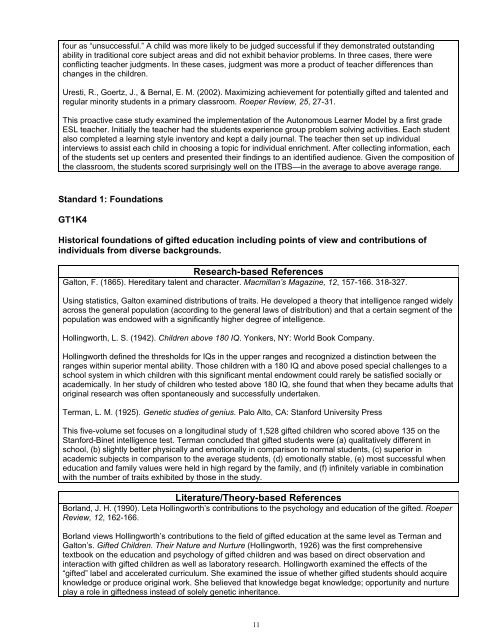Research Base - NAGC
Research Base - NAGC
Research Base - NAGC
You also want an ePaper? Increase the reach of your titles
YUMPU automatically turns print PDFs into web optimized ePapers that Google loves.
four as “unsuccessful.” A child was more likely to be judged successful if they demonstrated outstandingability in traditional core subject areas and did not exhibit behavior problems. In three cases, there wereconflicting teacher judgments. In these cases, judgment was more a product of teacher differences thanchanges in the children.Uresti, R., Goertz, J., & Bernal, E. M. (2002). Maximizing achievement for potentially gifted and talented andregular minority students in a primary classroom. Roeper Review, 25, 27-31.This proactive case study examined the implementation of the Autonomous Learner Model by a first gradeESL teacher. Initially the teacher had the students experience group problem solving activities. Each studentalso completed a learning style inventory and kept a daily journal. The teacher then set up individualinterviews to assist each child in choosing a topic for individual enrichment. After collecting information, eachof the students set up centers and presented their findings to an identified audience. Given the composition ofthe classroom, the students scored surprisingly well on the ITBS—in the average to above average range.Standard 1: FoundationsGT1K4Historical foundations of gifted education including points of view and contributions ofindividuals from diverse backgrounds.<strong>Research</strong>-based ReferencesGalton, F. (1865). Hereditary talent and character. Macmillan’s Magazine, 12, 157-166. 318-327.Using statistics, Galton examined distributions of traits. He developed a theory that intelligence ranged widelyacross the general population (according to the general laws of distribution) and that a certain segment of thepopulation was endowed with a significantly higher degree of intelligence.Hollingworth, L. S. (1942). Children above 180 IQ. Yonkers, NY: World Book Company.Hollingworth defined the thresholds for IQs in the upper ranges and recognized a distinction between theranges within superior mental ability. Those children with a 180 IQ and above posed special challenges to aschool system in which children with this significant mental endowment could rarely be satisfied socially oracademically. In her study of children who tested above 180 IQ, she found that when they became adults thatoriginal research was often spontaneously and successfully undertaken.Terman, L. M. (1925). Genetic studies of genius. Palo Alto, CA: Stanford University PressThis five-volume set focuses on a longitudinal study of 1,528 gifted children who scored above 135 on theStanford-Binet intelligence test. Terman concluded that gifted students were (a) qualitatively different inschool, (b) slightly better physically and emotionally in comparison to normal students, (c) superior inacademic subjects in comparison to the average students, (d) emotionally stable, (e) most successful wheneducation and family values were held in high regard by the family, and (f) infinitely variable in combinationwith the number of traits exhibited by those in the study.Literature/Theory-based ReferencesBorland, J. H. (1990). Leta Hollingworth’s contributions to the psychology and education of the gifted. RoeperReview, 12, 162-166.Borland views Hollingworth’s contributions to the field of gifted education at the same level as Terman andGalton’s. Gifted Children. Their Nature and Nurture (Hollingworth, 1926) was the first comprehensivetextbook on the education and psychology of gifted children and was based on direct observation andinteraction with gifted children as well as laboratory research. Hollingworth examined the effects of the“gifted” label and accelerated curriculum. She examined the issue of whether gifted students should acquireknowledge or produce original work. She believed that knowledge begat knowledge; opportunity and nurtureplay a role in giftedness instead of solely genetic inheritance.11
















